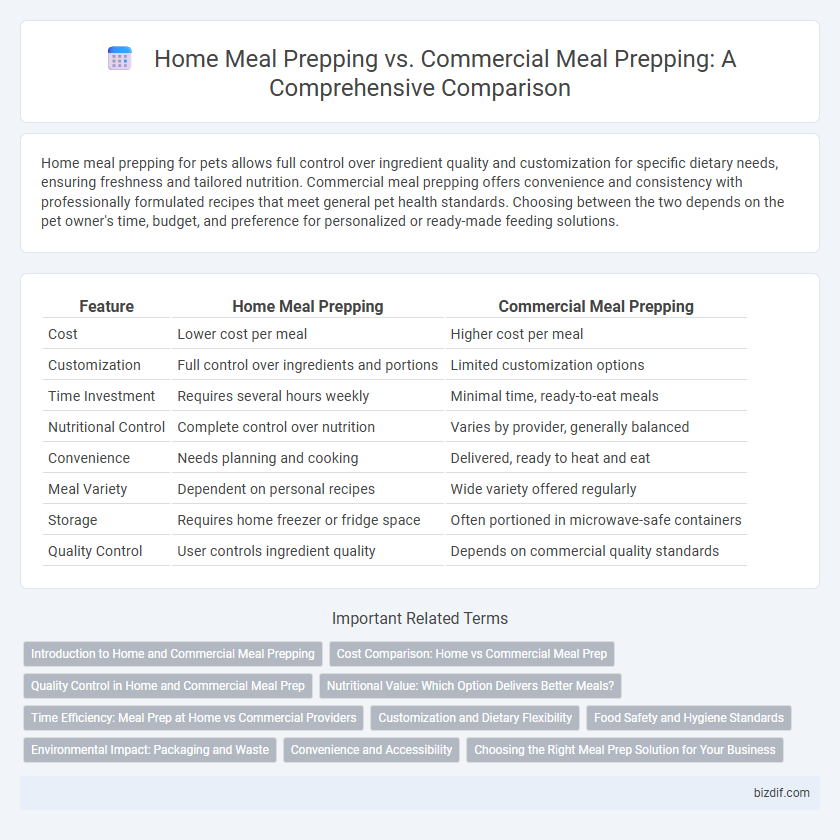Home meal prepping for pets allows full control over ingredient quality and customization for specific dietary needs, ensuring freshness and tailored nutrition. Commercial meal prepping offers convenience and consistency with professionally formulated recipes that meet general pet health standards. Choosing between the two depends on the pet owner's time, budget, and preference for personalized or ready-made feeding solutions.
Table of Comparison
| Feature | Home Meal Prepping | Commercial Meal Prepping |
|---|---|---|
| Cost | Lower cost per meal | Higher cost per meal |
| Customization | Full control over ingredients and portions | Limited customization options |
| Time Investment | Requires several hours weekly | Minimal time, ready-to-eat meals |
| Nutritional Control | Complete control over nutrition | Varies by provider, generally balanced |
| Convenience | Needs planning and cooking | Delivered, ready to heat and eat |
| Meal Variety | Dependent on personal recipes | Wide variety offered regularly |
| Storage | Requires home freezer or fridge space | Often portioned in microwave-safe containers |
| Quality Control | User controls ingredient quality | Depends on commercial quality standards |
Introduction to Home and Commercial Meal Prepping
Home meal prepping involves individuals preparing multiple meals at once in their own kitchens, tailored to personal dietary preferences and schedules, emphasizing control over ingredients and portion sizes. Commercial meal prepping, on the other hand, is a large-scale operation by companies producing pre-portioned meals for retail or delivery, prioritizing efficiency, consistency, and food safety standards. Both methods aim to save time and reduce food waste but differ significantly in scale, customization, and resource requirements.
Cost Comparison: Home vs Commercial Meal Prep
Home meal prepping typically costs significantly less per meal than commercial meal prepping due to bulk purchasing, reduced labor expenses, and elimination of packaging fees. Commercial meal prepping often includes premium pricing to cover overhead costs, marketing, and convenience factors, raising the average meal price by 50% to 100% compared to homemade options. By calculating per-serving costs, home meal prepping averages around $3 to $5 per meal, whereas commercial services often range from $8 to $15 per meal.
Quality Control in Home and Commercial Meal Prep
Home meal prepping allows for personalized quality control, ensuring ingredients are fresh, organic, and tailored to dietary preferences. Commercial meal prepping employs standardized procedures and advanced technology to maintain consistent quality, safety, and portion accuracy across large batches. Despite its scalability, commercial meal prepping may sacrifice some customization and ingredient transparency compared to home-prepared meals.
Nutritional Value: Which Option Delivers Better Meals?
Home meal prepping typically offers superior nutritional value due to full control over ingredient quality, portion sizes, and cooking methods, allowing for meals rich in fresh vegetables, lean proteins, and whole grains. Commercial meal prepping may rely on preservatives, sodium, and processed ingredients to extend shelf life, potentially reducing nutrient density and increasing additives. Choosing home meal prepping enhances customization for dietary needs and maximizes nutrient retention, making it a healthier option for balanced, nutrient-packed meals.
Time Efficiency: Meal Prep at Home vs Commercial Providers
Home meal prepping allows individuals to customize portions and ingredients, but often requires several hours per week to plan, shop, and cook. Commercial meal prepping services provide ready-to-eat or heat-and-serve meals, significantly reducing time spent on meal preparation to just minutes, ideal for busy schedules. The efficiency of commercial providers comes at a higher cost, while home prepping offers flexibility and cost savings but demands a greater time investment.
Customization and Dietary Flexibility
Home meal prepping offers unparalleled customization, allowing individuals to tailor meals precisely to their dietary needs and preferences, including specific allergens, macronutrient ratios, and flavor profiles. Commercial meal prepping provides convenience but often limits dietary flexibility due to standardized menus designed to appeal to a broad audience. Personalized meal plans crafted at home support strict dietary goals like keto, vegan, or gluten-free more effectively than bulk-prepared commercial options.
Food Safety and Hygiene Standards
Home meal prepping requires strict adherence to proper food storage, temperature control, and sanitation practices to prevent contamination and foodborne illnesses. Commercial meal prepping follows regulated food safety and hygiene standards set by health authorities, including regular inspections and certification processes to ensure consistent quality and safety. Maintaining clean workspaces and proper handling practices are critical in both settings to minimize risks and extend the shelf life of prepared meals.
Environmental Impact: Packaging and Waste
Home meal prepping significantly reduces environmental impact by minimizing single-use packaging and allowing reuse of containers, which cuts down on plastic waste compared to commercial meal prepping. Commercial meal prepping often relies on extensive plastic packaging and disposable containers, contributing to higher levels of non-recyclable waste and carbon emissions from production and disposal processes. Choosing home meal prepping promotes sustainability by lowering packaging consumption and enabling better waste management practices.
Convenience and Accessibility
Home meal prepping offers unparalleled convenience by allowing individuals to customize meals according to dietary preferences and control ingredient quality, making it easily accessible with common kitchen tools. Commercial meal prepping provides time-saving benefits through ready-to-eat or easy-to-heat meals distributed via subscription services, catering to busy lifestyles and those lacking cooking skills. Accessibility to commercial options is expanding through online platforms and retail stores, while home prepping remains cost-effective and adaptable to nutrient-specific goals.
Choosing the Right Meal Prep Solution for Your Business
Home meal prepping offers personalized control over ingredients and portion sizes, making it ideal for small businesses prioritizing customization and quality. Commercial meal prepping provides scalability and efficiency through standardized processes, suitable for larger operations aiming to meet high demand. Evaluating customer preferences, budget constraints, and production capacity is crucial to selecting the optimal meal prep solution that aligns with business goals.
Home meal prepping vs commercial meal prepping Infographic

 bizdif.com
bizdif.com